Checking your VAT number: How to verify UK and EU VAT registration
Checking VAT numbers helps verify business legitimacy and ensures compliance. Learn the simple steps to validate any VAT number.

Written by Jotika Teli—Certified Public Accountant with 24 years of experience. Read Jotika's full bio
Published Friday 7 November 2025
Table of contents
Key takeaways
• Verify VAT numbers before making purchases by checking supplier invoices, quotes, or company websites to ensure you can successfully reclaim VAT and avoid rejected claims.
• Use the appropriate validation tools for different regions—HMRC's online checker for UK numbers and the VIES VAT Validation Service for EU and international numbers.
• Implement systematic VAT number management by checking all new suppliers, storing validation confirmations with supplier details, and keeping records for six years as required by law.
• Contact suppliers immediately if their VAT number appears invalid after double-checking for typos, as you cannot reclaim VAT without a valid registration number on your invoice.
What is a VAT number?
A VAT number is a unique identification code that HMRC assigns to VAT-registered businesses. It allows you to charge VAT on sales and reclaim VAT on purchases.
UK VAT numbers follow specific formats:
- England, Scotland, Wales: Nine digits with 'GB' prefix, as all UK VAT registration numbers have nine digits.
- Northern Ireland: Nine digits with 'XI' prefix (for Northern Ireland Protocol trading)
You need your supplier's valid VAT number to reclaim VAT you have paid to them.
How to find a business' VAT number
Finding a VAT number starts with checking the supplier's invoice, where VAT-registered businesses must display their registration number.
Where to find VAT numbers:
- Check the header or footer of supplier invoices
- Look for VAT numbers on quotes, contracts or official documents
- Find VAT numbers in the contact or legal information on company websites
If the VAT number is missing: Contact your supplier immediately. You cannot reclaim VAT without a valid invoice showing their VAT registration number.
How to check a UK VAT number
Checking a VAT number's validity protects your business from rejected VAT reclaims and ensures compliance with HMRC requirements.
Why check VAT numbers:
- Avoid rejected claims by checking that VAT numbers are valid
- Prevent fraud by verifying new suppliers are VAT-registered
- Meet your legal obligations by keeping accurate records
Quick format check: UK VAT numbers must be exactly nine digits long with the correct prefix (GB or XI).
How to check EU and international VAT numbers
EU and international VAT checking requires different tools and formats compared to UK numbers.
EU VAT number format:
- Use a two-letter country code followed by the national number
- Check examples such as DE123456789 (Germany) and FR12345678901 (France)
- Use the VIES VAT Validation Service to check EU VAT numbers
Key differences:
- Check EU numbers without needing your own VAT number
- Get instant results from the VIES validation service
- Use VIES for Northern Ireland (XI) numbers; Great Britain businesses do not need to complete an EC sales list as of January 2021
Understanding VAT checker results
When you use a VAT checker, you will see either 'valid' or 'invalid'. A valid result means the number is correct and active. If you see 'invalid', check for typos. Some databases may not show new registrations made in the last 48 hours. If the number is still invalid, contact your supplier for the correct details before reclaiming VAT.
Is a VAT number the same as a UTR number?
A UTR number is not the same as a VAT number. These are completely separate tax identifiers with different purposes.
Key differences:
- Use a 10-digit UTR code for self-assessment tax returns
- Use a 9-digit VAT number for VAT-registered businesses
- Use UTRs for income tax and VAT numbers for sales tax
You cannot use a UTR number to reclaim VAT expenses.
Managing VAT checking for your business
Managing VAT checking for your business becomes easier with the right systems and processes in place.
Best practices for VAT number management:
- Check new suppliers: Verify VAT numbers before your first purchase
- Keep records: Store validation confirmations with supplier details, as official records must be kept for six years.
- Regular reviews: Re-check numbers if suppliers change registration
- Use technology: Integrate checking into your accounting workflow
Use modern accounting software to automatically validate supplier details and keep your VAT claims accurate. This saves you time and reduces the risk of rejected VAT reclaims.
Try Xero accounting software for free to simplify your VAT processes and manage your finances with ease.
FAQs on checking VAT numbers
Find answers to common questions about checking VAT numbers below.
What do I do if a supplier's VAT number is invalid?
First, check you've entered the number correctly. If it's still invalid, you should contact the supplier to confirm their details. Don't use the invoice to reclaim VAT until you have a valid number.
Can I check a VAT number without my own?
Some services, such as the HMRC helpline, may ask for your VAT details. Online checkers, including the VIES tool for EU numbers, usually do not require your own information.
How often should I check a supplier's VAT number?
Check the VAT number for any new supplier. For regular suppliers, you do not need to check every time, but re-verify if you have not done business with them recently.
Disclaimer
Xero does not provide accounting, tax, business or legal advice. This guide has been provided for information purposes only. You should consult your own professional advisors for advice directly relating to your business or before taking action in relation to any of the content provided.
Start using Xero for free
Access Xero features for 30 days, then decide which plan best suits your business.